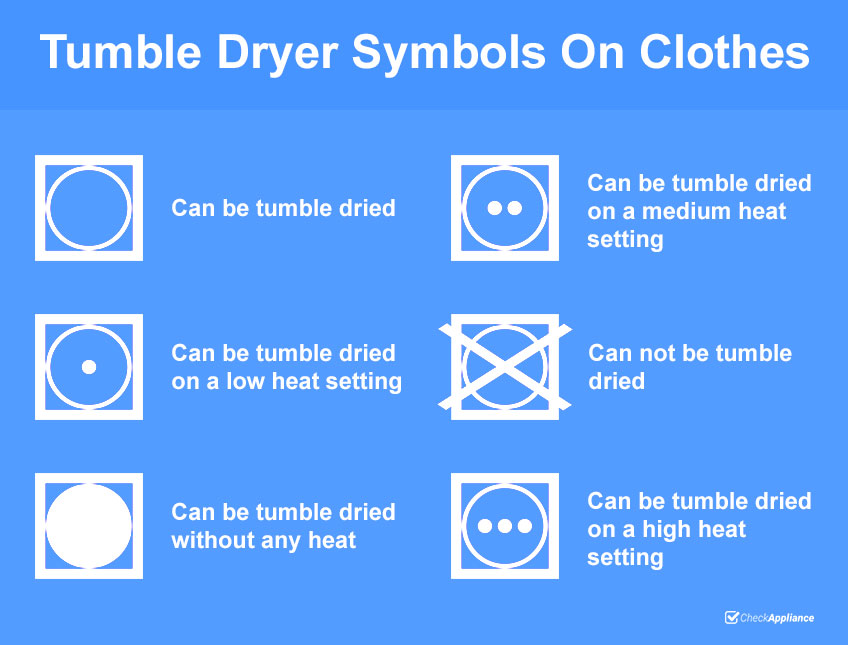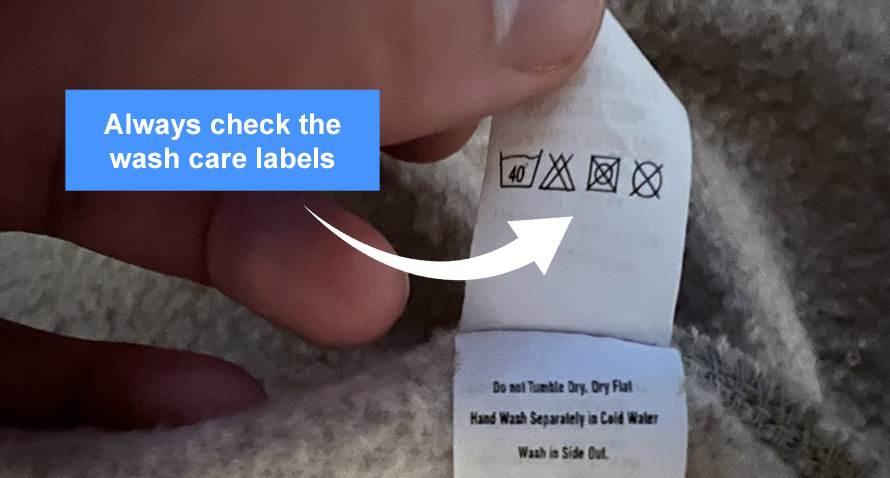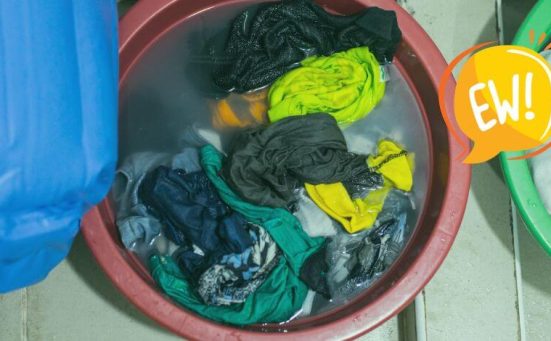
Can You Tumble Dry Polyester? (is it safe or does it shrink)
Polyester is one of the most common synthetic fabrics used in the clothing industry and you’ll be pleased to know you can tumble dry polyester.
However, as polyester is quick drying, you might not need to tumble dry your polyester clothes.
If you do decide that some of your polyester clothes need tumble drying, always select the cool program on your dryer.
Lots of clothes are now made from polyester or a blend with polyester anything from;
- Workwear
- School Uniforms
- Sports Kits
- Blankets
- Bedding
The main benefits of polyester is it can easily be washed and dried at home. Plus it’s a quick-drying fabric.
To prevent creasing, polyester garments should be taken directly from the washing machine to the tumble dryer.
Static Build Up
Polyester can be tumble dried at a low heat without any problems except the possible build up of static. As the items of clothing rub together in the dryer, they can become statically charged – which leads to static electricity when you’re sorting the clothes out after drying.
Easy Ways To Prevent Static Cling On Your Polyester Clothes
To help prevent this static from building up there are two things you can do;
- Use Dryer Sheets
Simply lay one dryer sheet on top of your clothes before you start the tumble dryer on a low or cool setting. This will prevent static cling as well as wrinkles and as they are coated with fabric softener, they will leave your clothes feeling soft and smelling great too. - Use Wool Dryer Balls
If you have already used fabric softener in your washing machine, you don’t need to use a dryer sheet. To prevent static cling in this case you should use wool dryer balls. These wool dryer balls absorb moisture from the clothes in the dryer. This makes the environment inside the dryer more humid which helps to remove static.
What The Tumble Dryer Symbols Mean On Polyester

Before placing any items of clothing in a tumble dryer we recommend checking the care label first. In some cases the label will give you direct instructions like “Hand Wash Only” or “Cool Dry Only”. Other items might just have a symbol and it’s important that you understand just what those symbols mean. Below is a list of the symbols and a short description of what each symbol means;
- Square With a White Circle
It’s fine to tumble dry - Square With White Circle, One Black Dot In Circle
This indicates that you can dry on normal or low heat - Square With White Circle, Two Black Dots In Circle
This indicates that you can dry on normal or medium heat - Square With White Circle, Three Black Dots In Circle
This indicates that you can dry on normal or high heat - Square With Black Circle
This indicates that the garment can be dried in a tumble dryer as long as no heat is applied - Square With White Circle And A Black X On Top
This indicates that the garment can not be dried using a tumble dryer
How To Dry Polyester Without A Tumble Dryer
Polyester is a quick-drying fabric and in many cases you will not need to tumble dry your polyester garments at all.
However, depending on the blend used to make your clothes, and in the absence of any care label, we would recommend the following alternatives for drying polyester and poly-blended fabrics.
Air Drying – Clothesline
As polyester is a quick-drying fabric, it will only take a short while to dry on a clothesline in the fresh air.
Even printed polyester clothes can be dried on a clothesline in direct, full sunlight without fear of fading.
In full sunlight polyester garments can be fully dry in as little as one hour.
Clothes Airer
Clothes airers (or clothes horses as they’re often called) have plenty of room to dry multiple garments on their lightweight but sturdy frame. They can be set up in the home, on the patio outside or even in the garage or shed.
Clothes airers use no energy and don’t heat up so your polyester garments could take up to 4 hours to dry completely or longer if the environment is damp.
Avoid using a heated airer to dry polyester clothes as these can become too hot for the fabric which could result in the fabric becoming structurally damaged and the clothes ripping.
Dehumidifier
If the weather is too bad outside and you really want your polyester clothes dried quickly, you might want to consider using a dehumidifier.
You’ll still need to arrange the clothes on an airer, but the dehumidifier placed close by will remove excess moisture much faster than just air drying alone.
SEE ALSO: The Best Dehumidifier For Drying Clothes
Electric Fan
If you don’t own a dehumidifier, placing an electric fan near the airer to increase the airflow will help dry your polyester garments.
It’s a good idea to open a window to allow the excess moisture to leave the room. If at all possible, use a dehumidifier as well as an electric fan to increase the speed of drying.
Retractable Clothesline
The retractable clothesline is a great idea if you are short on space. They consist of a wall mounted box which contains a braided nylon line.
The line can be pulled out and fixed at a point across the room to create an indoor washing line. Once the polyester garments are dry, the line is unhooked and it then retracts into the wall mounted box.
SEE ALSO: Our Top Recommended Retractable Washing Lines
Towel Roll Technique
For small polyester garments it’s possible to remove excess moisture using a dry towel. Simply lay the towel out flat, and place the damp garment on top of the towel.
Then roll the towel up as if it was a burrito and once fully rolled, apply pressure to the rolled up towel with your knee or twist the towel roll. Then unroll and remove the garment which should be virtually dry.
Spin Dryer
Most washing machines have a spin cycle and this is usually more than enough for polyester garments. This is because polyester doesn’t absorb anywhere near the amount of moisture that other fabrics can.
If you have hand washed any polyester garments they can be spun in a spin dryer, but they won’t need much spinning.
What Happens If You Tumble Dry Polyester?

It is perfectly fine to tumble dry polyester clothes at low temperatures. However, if you use too much heat you could experience the following;
- Shrinking Clothes
Polyester has a smooth texture which can shrink or even melt if exposed to high temperatures. Polyester garments should be washed and dried at lower temperatures and you should always follow the care labels. - Clothes Prone To Tearing
If polyester is exposed to temperatures which are too high for the material, even for a short period, it is possible to weaken the integrity of the material. This can lead to rips and tears forming in the fabric.
Frequently Asked Questions
It is perfectly safe to put polyester in a tumble dryer as long as the dryer is set to low/medium heat. It is also worth noting that as polyester doesn’t absorb as much moisture as some other materials, it will only need a short time in the dryer.
There are several ways you can dry polyester without a tumble dryer, you can; use an outdoor clothesline, use an airer (or clothes horse), use a retractable clothesline, roll the polyester garment up in dry towel like a burrito and squeeze, or hang the garment in front of a fan with a window open.
You can dry 100% polyester in a tumble dryer on a low/medium setting without fear of shrinking.
If polyester gets too hot, if the tumble dryer has been set at too high a temperature for polyester, for example, the material could melt, shrink or deform. Always wash and tumble dry polyester garments at low temperatures.
The main disadvantages of Polyester are; it is prone to a build up of static, holds odours more than natural fibres and polyester is less breathable than natural fibres which means it can make you feel too hot and sweaty in certain situations and environments.
Also, follow us on Pinterest ...



